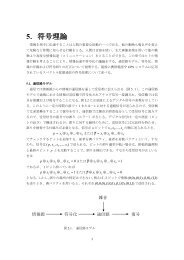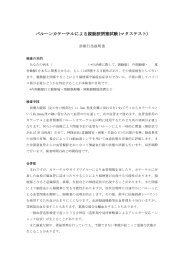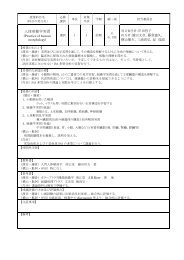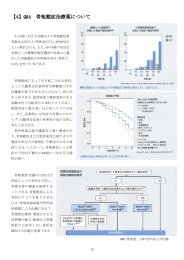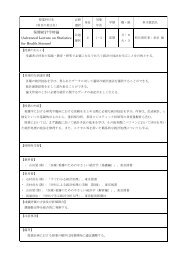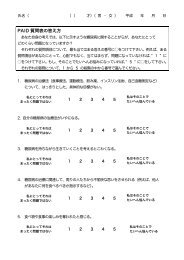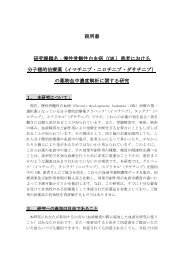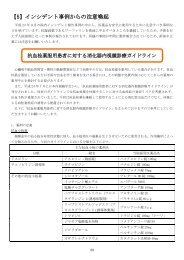fibulins: a versatile family of extracellular matrix proteins
fibulins: a versatile family of extracellular matrix proteins
fibulins: a versatile family of extracellular matrix proteins
Create successful ePaper yourself
Turn your PDF publications into a flip-book with our unique Google optimized e-Paper software.
REVIEWSBox 1 | The structure and biology <strong>of</strong> elastic fibresElastic fibres are special forms <strong>of</strong> <strong>extracellular</strong> <strong>matrix</strong> assembly, which provide resilienceto dynamic connective tissues and are crucial for the proper functioning <strong>of</strong> the lungs,arteries and skin. They can be readily identified at the ultrastructural level by theiramorphous appearance, as they are frequently associated with numerous micr<strong>of</strong>ibrils.The amorphous core consists mainly <strong>of</strong> elastin — a highly hydrophobic protein that isgenerated from the soluble precursor tropoelastin (70 kDa) and is extensivelycrosslinked after the enzymatic oxidation <strong>of</strong> lysyl residues. Important components <strong>of</strong>the micr<strong>of</strong>ibrils are several fibrillin is<strong>of</strong>orms (~350 kDa, length ~150 nm), which havearound 40 calcium-binding sites and some elastic properties. These micr<strong>of</strong>ibrils arebelieved to provide a scaffold for the deposition <strong>of</strong> elastin. More than 30 <strong>proteins</strong>,including some <strong>fibulins</strong> and collagens, have so far been identified as other components<strong>of</strong> some or all elastic fibres 81 . Elastic fibres are known to lose their regenerative potentialduring ageing and in certain obstructive diseases such as lung emphysema. Mutations inelastin and fibrillins are known to lead to various human disorders with skeletal,cutaneous, vascular and ocular malformations, and similar elastinopathies can begenerated in transgenic mice 82,83 .ANGIOGENESISA process <strong>of</strong> blood-vesselbranching, in which bloodvessels sprout from smallcapillaries.modules therefore seems well suited for makingnumerous associations that can produce the largecomplexes that are formed by perlecan, fibulin-2 andnidogens or fibronectin.Further candidates for forming basement-membraneinteractions with <strong>fibulins</strong> are several lamininis<strong>of</strong>orms (BOX 2). Such an interaction was first shownfor laminin-1 that binds fibulin-1 through its E3fragment, a distinct fragment that is formed bycleavage with elastase. The E3 fragment consists <strong>of</strong>the α1-chain laminin G-type (LG)4–5 modules andis derived from the α1-chain carboxyl terminus 4,53 .The same site <strong>of</strong> the laminin α2 chain and the adjacentα2LG1–3 modules were also shown to bindfibulin-1 and fibulin-2 with moderate affinities 54 .The fibulin-binding properties <strong>of</strong> other laminin α-chainis<strong>of</strong>orms (α3–α5) have not yet been examined.Laminin LG modules provide important cell-adhesionsites for integrin, dystroglycan and heparan sulphateproteoglycan receptors 53 , and their potential modulationby <strong>fibulins</strong> remains an interesting possibility to bestudied.The γ2 chain, which is unique to laminin-5, wasalso shown to bind fibulin-2 in affinity chromatographyexperiments, and the binding was attributed to ashort peptide sequence in the central region <strong>of</strong> the γ2short-arm structure 55 . Subsequent studies showedthat this central domain also binds fibulin-1 and thatthe interacting epitopes have a more complex structure,which includes a second binding site for fibulin-2on a laminin-type EGF-like (LE) module 56 . These twobinding sites can be separated on proteolytic processing<strong>of</strong> laminin-5, which is essential for its <strong>matrix</strong>deposition.Other ligands that bind fibulin-1 and fibulin-2are endostatins, which are released from the carboxy-terminalend <strong>of</strong> collagens XV and XVIII anddeposited into basement membranes and elastic tissues57–59 . Endostatins are potent inhibitors <strong>of</strong> ANGIOGENESISand their binding to <strong>fibulins</strong> might be required fortheir localization to the ECM, particularly in vesselwalls.Lectican proteoglycans. Another group <strong>of</strong> highlypotent fibulin ligands is represented by the lectican<strong>family</strong> <strong>of</strong> large chondroitin sulphate proteoglycans,which includes the cartilage-specific aggrecan, theubiquitously deposited versican and the brain-specificneurocan and brevican 60 . The lectican <strong>family</strong> core <strong>proteins</strong>tructure includes an amino-terminal globulardomain, which has a high binding affinity for hyaluronan,a central elongated region that is used for chondroitinsulphate attachment, and a carboxy-terminalglobular domain that has a complex modular structure,which includes a C-type lectin domain. Thislectin domain in aggrecan and versican has beenshown to bind fibulin-1 with moderate affinity. Thisbinding is calcium-dependent, but independent <strong>of</strong> theN-glycosylation <strong>of</strong> fibulin-1 (REF. 61). The same twolectin domains also bind fibulin-2 with high affinity.These interactions are specific, as no, or only low,binding activity was found for the lectin domains <strong>of</strong>neurocan and brevican 62 . The binding epitopes weremapped to a short stretch <strong>of</strong> cbEGF-like modules indomain II <strong>of</strong> both <strong>fibulins</strong>. Furthermore, fibulin-2 wasshown to form networks with aggrecan and versican,but only the four-arm structure <strong>of</strong> fibulin-2 seemed tobe active 62 (FIG. 4). An important conclusion from thesedata is that there is a prominent role for <strong>fibulins</strong> (inaddition to that <strong>of</strong> hyaluronan) in the formation <strong>of</strong>huge proteoglycan networks. Some in vivo evidencefor such networks was discussed above for the endocardialcushion tissue 32 . Another function for theseinteractions is indicated by the binding <strong>of</strong> fibulin-1 toaggrecanase (a disintegrin and metalloproteinase withthrombospondin motifs 1; ADAMTS-1), which mighttarget this specific protease to proteoglycans for theircontrolled degradation (S. Agraves and M. Iruela-Arispe, unpublished observations).Specific fibulin-1 ligands. A few more interactionshave been described for fibulin-1, which do not seemto be shared by fibulin-2. A weak affinity (K d= 3 µM)was described for the fibrinogen βB chain, and thisinteraction causes fibulin-1 to associate with, and toinhibit the formation <strong>of</strong>, fibrin clots 63,64 .However,fibulin-1-deficient mice that lack the circulating form<strong>of</strong> this protein show no obvious defect incoagulation 65 , which indicates that this function is notcrucial. Two more ligands were initially identified byyeast two-hybrid screening and were subsequentlyconfirmed using recombinant fibulin-1 in other bindingassays. The first ligand was connective-tissuegrowth factor (CTGF), as well as related members <strong>of</strong>this protein <strong>family</strong>, which correlates well with the coexpression<strong>of</strong> fibulin-1 and these growth factors 66 .Theother ligand was β-amyloid precursor protein (APP),which binds to cbEGF3–7 <strong>of</strong> fibulin-1 in a calciumdependentfashion 35 . This interaction inhibits APPstimulation <strong>of</strong> neurite outgrowth and neuronal stemcellproliferation. A similar role in vivo is indicated bythe presence <strong>of</strong> fibulin-1 in some neurons 20 , but it isnot yet known whether fibulin-1 is also incorporatedinto amyloid deposits in the brain.NATURE REVIEWS | MOLECULAR CELL BIOLOGY VOLUME 4 | JUNE 2003 | 485© 2003 Nature PublishingGroup



